Which Animals Have A Ventral Nerve Cord
| Animal | Nervous Arrangement Features/Behavior |
| Ameba/Paramecium | Although the ameba is a unmarried-celled creature, it does announced to exist sensitive to the environment. This tiny brute moves away from lite, but it has no photodetectors or eyes. The paramecium, some other unmarried-celled beast, also has no specialized sensory structures. Nonetheless, it avoids common cold, oestrus and chemicals by backing up and moving away. |
| Euglena (flagellate) Paradigm courtesy of Biodidac | Euglena have an eyespot that acts as a shield for a light sensitive receptor. This pocket-sized animal tin can observe the forcefulness and management of calorie-free. It prefers a location with moderate low-cal and moves away from darkness and bright light. Euglena probably use this receptor to keep themselves in low-cal which they utilize for photosynthesis. Euglena use photosynthesis for free energy although they can eat solid food (like animals) if they are kept in the darkness. |
| Sponge Image courtesy of Biodidac | Sponges are the only multicellular animals without a nervous system. They practise not have any nerve cells or sensory cells. All the same, touch or pressure to the exterior of a sponge volition cause a local contraction of its body. |
| Hydra | The hydra has a nervous system characterized by a nerve net. A nerve net is a collection of separate, only "connected" neurons. Neurons are connected by synapse. Advice between neurons tin be in both directions at the synapse within a nerve net. The nerve net is concentrated around the mouth. Dissimilar higher animals, the hydra does not have any grouping of nerve cell bodies. In other words, there are no ganglia. The hydra does have specialized cells for touch and chemic detection. |
| Jellyfish | Like the hydra, the jellyfish has a nervous organization characterized by a series of interconnected nerve cells (a nerve net). The nervus internet surrounds the whole body of the jellyfish. Some jellyfish (for example, Aurelia) have specialized structures chosen "rhopalia". These rhopalia have receptors for:
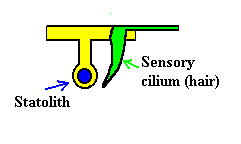 Shown to the left is a statocyst. When the animal moves and body is tilted, the statocyst makes contact with the cilium. When the cilium bends, information technology causes action potentials to burn in a nerve. This provides information to motion muscles. Shown to the left is a statocyst. When the animal moves and body is tilted, the statocyst makes contact with the cilium. When the cilium bends, information technology causes action potentials to burn in a nerve. This provides information to motion muscles. |
| Anemone | Like the jellyfish and hydra, the anemone has a nervus cyberspace. |
| Flatworms (Planaria) | The nervous organisation of the flatworm has an arrangement unlike from the invertebrates describe to a higher place. Information technology does take a nerve net, but these are connected past long nervus cords. These cords are connected to cognitive ganglia located in the head region. The central nervous system has been described as "ladder-like" because of the nerves connecting the nerve cords. Flatworms have "auricles" that projection from the side of the head. These auricles contain chemoreceptors that are used to observe nutrient. Flatworms also have eyespots chosen "ocelli". The ocelli are sensitive to light and are connected to the cognitive ganglia. Generally, the flatworm avoids light. |
| Earthworm | The nervous system of the earthworm is "segmented" but like the residue of the torso. The "brain" is located to a higher place the throat and is connected to the kickoff ventral ganglion. The brain is important for move: if the brain of the earthworm is removed, the earthworm will move continuously. If the first ventral ganglion is removed, the earthworm will stop eating and volition not dig. Each segmented ganglion gets sensory information from only a local region of its body and controls muscles merely in this local region. Earthworms have impact, light, vibration and chemical receptors all along the entire trunk surface. |
| Sea Star ("Starfish") | The nervous system of the starfish is very uncomplicated...at that place is no brain and at that place are not even any ganglia to coordinate movement. The nervous system is characterized by a nerve ring that surrounds the mouth. A radial nervus branches off of the nervus ring and extends to each arm. The pic on the left shows one of 3 nerve nets that extend throughout the body. Starfish have an interesting way of detecting light. They have "eyespots" at the tip of each arm. The eyespot contains calorie-free sensitive pigments that allow the starfish to detect shadows and changes in the brightness of light. |
| Snails | The nervous system is characterized by half-dozen ganglia. Some snails have chemosensors called "osphradia" in the curtain cavity. These osphradia are used to detect chemicals in the air or water. |
| Aplysia (Body of water Hare) | The aplysia has several ganglia that are connected by long nerves. The cell bodies of some neurons are very big (1 mm in diameter). Neuroscientists like these cells because they are easy to: one) come across 2) record action potentials 3) inject chemicals. |
| Bivalves (clams, scallops) | The nervous arrangement is comprised of three pairs of ganglia (cognitive, visceral and pedal) each associated with the esophagus, muscles close to the shell, and human foot. |
| Crab | The crab has a condensed central nervous system consisting of several ganglia. |
| Lobster | The lobster has a brain connected to a kickoff ventral ganglion. This ganglion is located under its tummy. A double nerve cord extends from the first ventral ganglion to a serial of paired segmental ganglia running through the entire body on the ventral side of the animate being. |
| Insects (such as grasshoppers) | The grasshopper has a encephalon located between its optics, just above the esophagus. The brain is connected to the 1st ventral ganglion by a pair of ventral fretfulness that surround the gut. The grasshopper can exercise many things, similar walking and jumping, WITHOUT its brain. The brain is used to relay sensory information to other parts of the body and to aid with motility. The first ventral ganglion is used primarily to command movement of the mouth. The segmental ganglia throughout the length of the grasshopper are connected to the first ventral ganglion past a double nerve cord and serve to coordinate local activities. Insects have a compound eye containing many unlike units called "ommatidia". Each ommatidia is like an private lens that samples a small part of the visual field. There tin be thousands of ommatidia in a single insect center. Science fiction/horror/monster movies that prove an insect that sees thousands of identical images of the Unabridged visual field are Wrong -- an insect sees just ONE picture at a fourth dimension because each ommatidia sees but a small part of the entire field. Some insects are sensitive to ultraviolet calorie-free and others can find infrared wavelengths of light. |
| Octopus | The octopus has the almost complicated brain of all the invertebrates. The octopus nervous system has most 500,000,000 neurons, with two-thirds of these neurons located in the arms of the octopus. Neurons in the octopus brain are arranged in lobes and tracts that are more specialized than simple ganglia. An octopus has a "good" retentiveness and can likewise learn. The eye of the octopus is very similar to that of vertebrates in that it has a cornea, lens, iris and retina. It tin also focus and form images. Even so, the octopus middle is unlike from that of vertebrates in that it focuses light by moving the lens closer and further away from the retina. The vertebrate middle focuses past changing the shape of the lens. An octopus can perceive shape, color intensity and texture. Some other difference is that the eye of the octopus has NO blind spot because the nervus cells leave from the outside of the eyeball. The octopus also has a statocyst located adjacent to the brain. The statocyst is used to detect changes in gravity and respond to dispatch. |
| Did you know? |
|

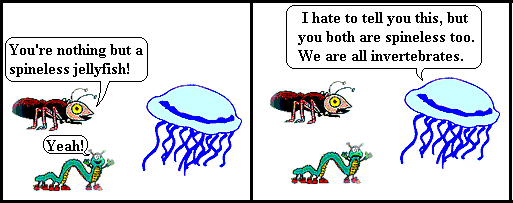
Source: https://faculty.washington.edu/chudler/invert.html
Posted by: sansomcombehe.blogspot.com




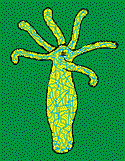
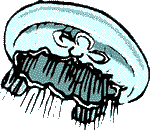
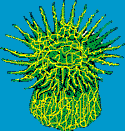

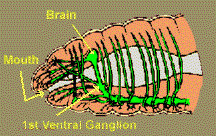
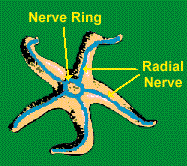



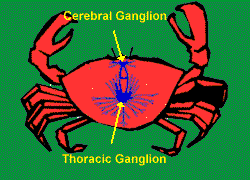
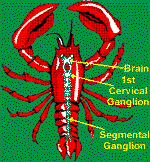
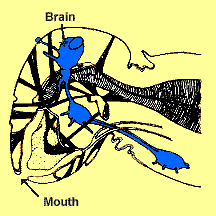
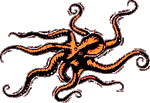

0 Response to "Which Animals Have A Ventral Nerve Cord"
Post a Comment